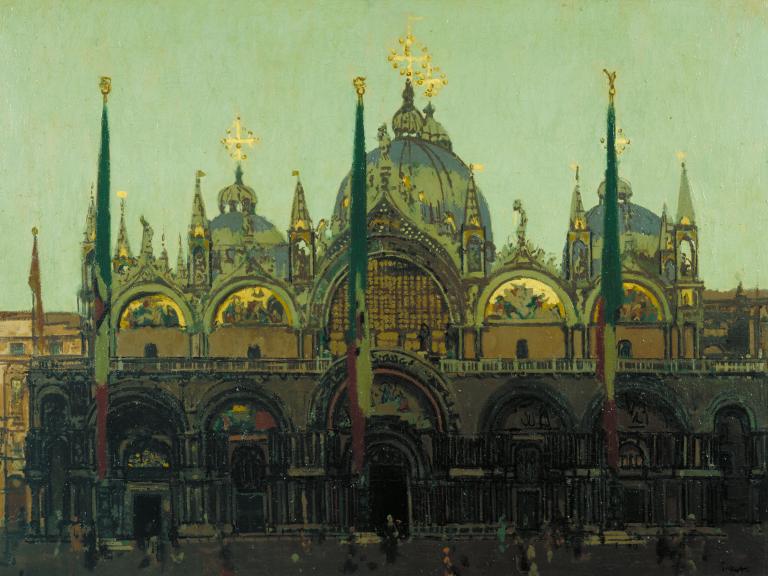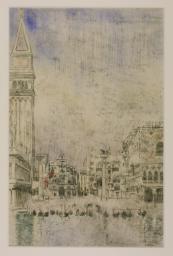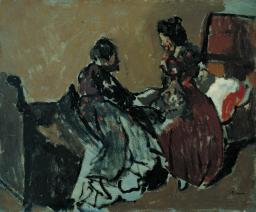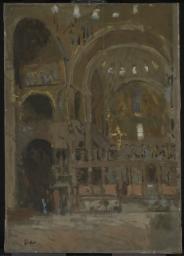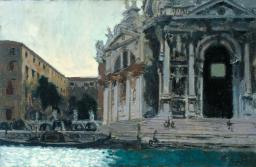Walter Richard Sickert St Mark's, Venice (Pax Tibi Marce Evangelista Meus) 1896
Walter Richard Sickert,
St Mark's, Venice (Pax Tibi Marce Evangelista Meus)
1896
The Latin of the picture’s title is the motto of Venice: ‘Peace be unto you, Mark my Evangelist.’ This painting shows the front elevation of St Mark’s Basilica in muted colours at early evening. Shadows gather in the shallow foreground while the gold crosses atop the Byzantine domes glint in the waning daylight. During his visit to Venice in 1895–6 Sickert chose to paint the conventional tourist attractions, as described in the art historian John Ruskin’s popular treatise The Stones of Venice (1851–3).
Walter Richard Sickert 1860–1942
St Mark’s, Venice (‘Pax Tibi Marce Evangelista Meus’)
1896
Oil paint on canvas
908 x 1200 mm
Inscribed by the artist ‘Sickert’ bottom right
Bequeathed by General Sir Ian Hamilton, G.C.B., G.C.M.G., D.S.O. 1949
N05914
1896
Oil paint on canvas
908 x 1200 mm
Inscribed by the artist ‘Sickert’ bottom right
Bequeathed by General Sir Ian Hamilton, G.C.B., G.C.M.G., D.S.O. 1949
N05914
Ownership history
Purchased from the artist by Jean, Lady Hamilton (1886–1941); bequeathed by her husband General Sir Ian Hamilton (1853–1947) to Tate Gallery 1949.
Exhibition history
1897
18th Exhibition of the New English Art Club, Dudley Gallery, London, April–May 1897 (9, as ‘Pax tibi Marce Evangelista Meus’).
1900
?Walter Sickert, Galerie Durand-Ruel, Paris, December 1900 (4, as ‘Pax tibi Marce Evangelista Meus’).
1904
?Bernheim-Jeune, Paris, June 1904.
1905
Fifth Exhibition of the International Society of Sculptors, Painters and Gravers, New Gallery, London, January–February 1905 (313, as ‘Pax tibi Marce Evangelista Meus’).
1905
The International Society of Sculptors, Painters and Gravers’ Exhibition, Corporation of Manchester Art Gallery, March–May 1905 (161, as ‘Pax tibi Marce Evangelista meus’).
1905
Exhibition of the International Society of Sculptors, Painters and Gravers, Corporation Art Gallery, Cartwright Memorial Hall, Bradford, October–December 1905 (287, as ‘St Mark’s, Venice’).
1941
Sickert Exhibition, National Gallery, London, August–December 1941 (10a).
1942
Sickert 1860–1942, Temple Newsam, Leeds, March–May 1942 (131, as ‘St. Mark’s, Venice’).
1942–3
A Selection from the Tate Gallery’s Wartime Acquisitions, (Council for the Encouragement of Music and the Arts tour), Royal Exchange, London, July–August 1942, Cheltenham Art Gallery, September 1942, Ashmolean Museum, Oxford, October 1942, Galleries of Birmingham Society of Arts, November–December 1942, Fitzwilliam Museum, Cambridge, January–February 1943, Victoria Art Gallery, Bath, February–March 1943, National Museum of Wales, Cardiff, March–April 1943, Manchester City Art Gallery, April–May 1943, Philharmonic Hall, Liverpool, May–June 1943, National Gallery of Scotland, Edinburgh, June 1943, Glasgow Museum and Art Gallery, Kelvingrove, July 1943, Laing Art Gallery, Newcastle upon Tyne, August 1943 (3, as ‘St Mark’s, Venice’).
1960
Sickert: Paintings and Drawings, (Arts Council tour), Tate Gallery, London, May–June 1960, Southampton Art Gallery, July 1960, Bradford City Art Gallery, July–August 1960 (69).
1989–90
W.R. Sickert: Drawings and Paintings 1890–1942, Tate Gallery, Liverpool, March 1989–February 1990, Tate Gallery, London, July–September 1990 (25, reproduced).
1992–3
Sickert: Paintings, Royal Academy, London, November 1992–February 1993, Van Gogh Museum, Amsterdam, February–May 1993 (21, reproduced).
1998
Two British Impressionists: Walter Sickert and Philip Wilson Steer, Norwich Castle Museum, January–April 1998 (22, reproduced).
2004
Walter Richard Sickert: The Human Canvas, Abbot Hall Art Gallery, Kendal, July–October 2004 (5, reproduced).
2004
Walter Sickert: ‘drawing is the thing’, Whitworth Art Gallery, Manchester, October–December 2004 (3.14, reproduced).
2009
Sickert in Venice, Dulwich Picture Gallery, London, March–May 2009 (4, reproduced).
2010
The Art of Walter Sickert, The Lightbox, Woking, May–July 2010 (no catalogue).
2011
Pure Gold: 50 Years of the Federation of British Artists, Mall Galleries, London, February 2011 (no number, reproduced p.48).
References
1943
Lillian Browse and Reginald Howard Wilenski, Sickert, London 1943, p.39.
1951
Hesketch Hubbard, A Hundred Years of British Art, 1851–1951, London 1951, reproduced pl.64.
1955
Anthony Bertram, Sickert, London and New York 1955, reproduced pl.11, as St Mark’s, Venice.
1960
Lillian Browse, Sickert, London 1960, pp.26, 27, 66, 100–1.
1964
Mary Chamot, Dennis Farr and Martin Butlin, Tate Gallery Catalogues: The Modern British Paintings, Drawings and Sculpture, vol.2, London 1964, p.637, reproduced pl.XIII.
1973
Wendy Baron, Sickert, London 1973, pp.47–9, 316 no.100, reproduced pl.68.
2001
David Peters Corbett, Walter Sickert, London 2001, pp.21, 24, 25, reproduced fig.14.
2006
Wendy Baron, Sickert: Paintings and Drawings, New Haven and London 2006, no.102.2.
Technique and condition
St Mark’s, Venice (‘Pax Tibi Marce Evangelista Meus’) is a large-format work painted on primed stretched canvas. The cloth appears to be heavy linen prepared with an off-white primer with no visible separate sizing layer on the canvas. A thin wash of dark paint has been applied over the priming, forming an optical ground. It was probably applied by Sickert and appears to be common to his works of this period. No initial drawing or squaring up is evident. Instead, the composition is drawn using black paint applied with a stiff brush, which has produced clearly defined brushmarks in the surface texture. It is possible that the artist worked directly before the subject. In a lecture to students attending the Manchester Painting School in 1925, Sickert recalled ‘with regret ... how he, too, had once set up Gargantuan canvases on the piazza before St Mark’s’.1
The artist blocked in the main colours, probably premixed on a palette; dull blues are visible in the lower layers of the sky and brown in the buildings. He then used a narrow tonal range and dark colours, in what is a dark ground technique on top of earlier dark colours. In general the paint is brushed on thickly, but is smoothly worked, giving the appearance of riding on the slubs of the coarse-textured canvas. There appears to be little tonal difference between earlier and later applications but this effect may be, at least partly, due to the fact that the painting has been varnished and later lined. In addition, the whole painting will have darkened since completion as the dark underlayers now have a greater effect on overlying oil paint layers that have increased in transparency over time. While these changes are not dramatic they do alter the subtle tonal balance of the work and make the work appear darker than Sickert intended.
Stephen Hackney
June 2004
Notes
How to cite
Stephen Hackney, 'Technique and Condition', June 2004, in Robert Upstone, ‘St Mark’s, Venice (‘Pax Tibi Marce Evangelista Meus’) 1896 by Walter Richard Sickert’, catalogue entry, May 2009, in Helena Bonett, Ysanne Holt, Jennifer Mundy (eds.), The Camden Town Group in Context, Tate Research Publication, May 2012, https://wwwEntry
Background
The Latin part of this work’s title is the motto of the city state of Venice: ‘Peace be unto you, Mark my Evangelist.’ Mark is the city’s patron saint, and his emblem of a winged lion guarding his Gospel is represented in Venice’s coat of arms. The remains of St Mark were stolen by Venetian merchants from Alexandria in 828, but were lost in 976 after a fire destroyed the original basilica that had been built to house them. His body was miraculously rediscovered in 1094, the year the new Basilica of St Mark’s was consecrated.1
Sickert visited Venice for the first time in October 1894 with his wife Ellen, and they returned there the following autumn, staying in a flat overlooking the Zattere that belonged to a friend of her family. Sickert wrote to his friend Philip Wilson Steer:
Venice is really first-rate for work ... and I am getting some things done. It is mostly sunny and warmish and on cold days I do interiors in St Mark’s ... St Mark’s is engrossing and the Ducal Palace and 2 or 3 Renaissance gems, the Miracoli and S. Zaccharia and the Scuola di San Marco. Of course one gets familiar with Tintoretto and Titian and Veronese ... The more one sees of them ... the more preposterous is the pessimistic contention that we who live now should not paint. We aim at and achieve totally different results, results that they neither dreamt of nor could compass. A fine Whistler or Degas or Monet could hang with any of them. It would be intrinsically every bit as good, and for us have the added sparkle and charm of novelty. 2
On his visit to Venice in 1895–6 Sickert’s choice of picture subjects was quite conventional, being explorations of well-trodden tourist locations. Since its publication between 1851 and 1853, Ruskin’s Stones of Venice had become enormously popular and helped build a passion for all things Venetian in Britain over successive decades. A tangible record of this enthusiasm, which remains today, was the widespread imitation of Venetian Gothic architecture in London and other cities, evident in rows of terraced houses and corner pubs. By the time Sickert arrived in Venice, pictures of ‘la Serenissima’ were a popular and profitable component of the annual Royal Academy exhibition and the Paris Salon. Pictures of the city had, of course, been bought intermittently by British collectors since the time of Canaletto and Francesco Guardi, but a renewed enthusiasm peaked in the 1880s and 1890s. At this time large numbers of artists from many countries went to work in Venice to portray its picturesque canals and, most commonly, sentimental genre scenes of the inhabitants. The leading continental exponents of this type of picture were two Austrian painters, Cecil van Haanen (1844–1914) and Eugene von Blaas (1843–1932), whose style and choice of subject exerted a strong influence on the work of British painters such as Henry Woods (1846–1921). By 1886 the Art Journal was able to identify a ‘modern Venetian school’ whose foremost members were Woods, Luke Fildes (1844–1927) and William Logsdail (1859–1944), noting that:
Home-staying Englishmen, if they were years ago contented with such indistinct impressions of Venice as they received from Turner’s pictures or the stanzas in ‘Childe Harold’, are now familiar with another Venice, quite as poetic, quite as suggestive of romance, the Venice of today. Following the best of modern Art, which makes the real its aim and end, this clever Venetian school has carried us beyond Venice the romantic to Venice the actual, and has created our present interest in the delightful comedy of her streets and people ... yet they are not content merely to reproduce the noble beauty of her architecture or the lustrous hues of her landscape. They use these, yes; but as a background against which to set some scene of human interest, trivial at times, but always true.3
Sickert’s paintings of 1895–6 are devoid of human incident, but the popularity in London of anecdotal genre scenes of Venetian life adds an interesting background to his decision to paint series of figures in interiors on his 1903–4 visit (see Tate N05296). Similarly, while Sickert’s ‘view pictures’ of 1895–6 are different from the work of Fildes, Logsdail or Woods, the shared enthusiasm and market for scenes of Venice is an important context in which to consider their creation.
Inspiration and related works

James Abbot McNeill Whistler 1834–1903
Nocturne: Blue and Gold, St Mark's, Venice 1880
Oil paint on canvas
445 x 597 mm
National Museum of Wales, Cardiff
Photo © National Museum of Wales
Fig.1
James Abbot McNeill Whistler
Nocturne: Blue and Gold, St Mark's, Venice 1880
National Museum of Wales, Cardiff
Photo © National Museum of Wales
While Whistler was in Venice, Ruskin’s disciple John Wharlton Bunney (1828–1882) was painting his own meticulous record of the basilica, St Mark’s as it Looks in the Early Morning of a Sirocco Day 1877–82 (Ruskin Gallery, Guild of St George, Sheffield Galleries & Museums Trust).4 Seated before his subject, Bunney created a 7½ feet wide record of the building in exacting architectural detail.5 It is a completely frontal composition in which, like Sickert’s St Mark’s, the building fills almost all the available picture space. Whether Sickert was aware of this work, which enjoyed great publicity when it was exhibited at the Fine Art Society in London in 1882, is unknown. But there are striking similarities between the pictures, in their format, spatial composition and in recording the lighting effects of a precise time of day.
In Sickert’s St Mark’s, Venice (‘Pax Tibi Marce Evangelista Meus’), the sun reflected on the mosaics and gold crosses on the Byzantine domes and the gathering shadows at ground level indicate that the sun is low in the sky. St Mark’s Basilica faces west, and so the time represented is the end of the day, as the sun sinks. The painter Alfred Thornton’s recollection that Sickert worked ‘early and late’ bears out this timing.6 But it seems likely that a canvas of this size and complexity, with a carefully built up paint surface where each layer of paint has been allowed to dry fully, would more likely have been one that Sickert worked on after his return to London in the summer of 1896.7 He had a large amount of reference material on which to base such pictures, including both photographs and drawings.8 Indeed, Sickert’s full-frontal, planar approach to St Mark’s, Venice, with the building occupying almost all the picture space and the foreground reduced to a minimum, is like an illustration in a guidebook.
In making the oil painting Sickert may have relied on a large pencil and watercolour drawing, Façade of St Mark’s, Venice c.1895 (Manchester City Art Gallery),9 which is squared up for transfer in one-inch squares and is roughly half the size of the painting. The scale of St Mark’s Basilica in the drawing is exactly half what it is in the painting, and so it might therefore be assumed it is the source for the oil.10 Figures are sketched in the same positions, and in the colour notes Sickert has written in the top left corner, ‘all markings | no shadows’. However, no squaring up on the canvas is visible.
Tate’s painting may have had a complex evolution, and there are other related oils that might have played a part in its origin. Sickert made a certain number of paintings in front of the subject on this trip to Venice, writing to Steer that he aimed:
To see the thing all at once. To work open and loose, freely, with a full brush and full colour. And to understand that when, with that full colour, the drawing has been got, the picture is done.11
Among these works made on the spot are two 6¼ x 9½ inch pictures of St Mark’s: an oil on panel study of the façade (private collection);12 and an upright oil on paper laid on panel study of the central section and principal dome (private collection).13 This dome is not included in the composition of the first ‘pochade’, as the constraint of the picture space does not allow it, and it is as if Sickert has made the second study so that he has the relevant information to paint a full treatment of the basilica. Another 7¼ x 9½ inch oil on panel study, once belonging to Jacques-Emile Blanche, shows the whole of the façade and the foreground filled densely with figures.14 The treatment is sketchy and spontaneous. A greatly more finished oil study, measuring 8¾ x 11¾ inches is in the Ashmolean Museum, Oxford, and is almost identical in format and drawing to the Tate work.15 An interim canvas, between this study and the Tate picture, is Façade of St Mark’s, Venice c.1895–6 (private collection),16 which is roughly half its size and painted in a much looser, less delineated manner. Of a similar size is The Façade of St Mark’s, Red Sky at Night c.1896 (Southampton City Art Gallery),17 which, interestingly, introduces another schema of lighting or time of day. The Tate picture is one of the largest of Sickert’s treatments of this composition, although bigger still is The Façade of St Mark’s, Venice, which was on loan to Leeds City Art Gallery for several decades (private collection)18 and measures 45 x 60 inches. Another version about the same size as the Tate picture belongs to the British Council,19 and a further treatment measuring 19 x 24 inches is listed by Wendy Baron.20 Around 1902 Sickert produced an etching of the subject, evidently based on the Manchester City Art Gallery drawing, which was printed in six states, the final measuring 240 x 312 mm.21
It would probably be simplistic to see these works as a sort of linear progression, from study to finished work, from small to large. Some were made in Venice and others in London, on Sickert’s return. Tate’s painting can be dated with some certainty because it bears a label with the Latin title, so confirming that it was the version exhibited at the New English Art Club in April 1897. As the art historian Wendy Baron warns, Sickert often returned to an earlier subject much later in his career and, while Tate’s picture can be dated with some precision, other versions could have been made significantly later. She highlights his comment in a letter to his friend Ethel Sands during the First World War: ‘When I have done S. Mark’s and the Rialto I shall be through with this chewing of old cud under which I chafe.’22
Baron has noted additionally that on his way to Venice in 1895 Sickert may well have seen Claude Monet’s exhibition of paintings at Durand-Ruel’s in Paris. Here Monet displayed twenty canvases showing Rouen Cathedral at different times of day.23 This could well have been Sickert’s inspiration for his series of views of St Mark’s, and the fullest realisations of the subject certainly differ in their lighting and hence time of day that they depict.
Ownership
The first owner of St Mark’s, Venice (‘Pax Tibi Marce Evangelista Meus’) was Jean, Lady Hamilton (1886–1941). Sickert first met her in Venice in spring 1904, when their gondolas pulled alongside each other at the island of Burano.24 Lady Hamilton left a dramatic diary portrait of their subsequent meeting when she invited him to tea:
Turning I saw coming towards us, through the light and shade of the long pergola, the charming figure of Walter Sickert. It was late – tea all cold. I got up at once and went to meet him, and felt immediately I had known him a long while. I said, ‘Does a tea party frighten you?’ He laughed [and] said, ‘No’.25
Sickert evidently set out to charm Lady Hamilton, and enjoyed a flirtatious conduct with her, as he so often did with women who were intelligent, well bred, and who had husbands whose income might finance the purchase of his pictures. Married to a Boer War hero, Lady Hamilton had an interest in art, and also wrote novels.26 She visited Sickert’s exhibition at Bernheim-Jeune in Paris on 31 May 1904, the day before it opened. She recorded the visit in detail in her diary:
I wish Mr Sickert was not so much influenced by Manet and Degas ... I was determined to see Mr Sickert’s pictures at Bernheimer’s gallery ... I met Monsieur Blanche, the artist, there just going away ... he was charming for me, and went at once and got me a catalogue with a charming little notice in it of Mr Sickert, written by himself. I felt shy of keeping him, and evidently expected him to go, but he would not, and showed me many of the pictures, pointing out their beauties, taking them from the walls to bring them into the light to show me; some were very tiny and it was getting dark. He praised Mr Sickert very much, and said he wished his work was better known ... I bought two of Mr Sickert’s pictures of St Mark’s in Venice. I paid £32 for one ... I am excited about his work – much of it I don’t understand, some of it seems to mock one, but knowing him I am certain this is not so, and that it is all seriously studied.27
She was shown round by the French painter Jacques-Émile Blanche who Sickert had asked to hang the show in his absence. Jean Hamilton praised Sickert’s views of Venice and Dieppe, describing them as ‘full of appeal – sad – wan – touching’.28 But she expressed a strong antipathy for his Venetian figure compositions, believing they demonstrated ‘brutal mastery over the reality of things’, presumably an oblique reference to their sexual nature.29 Lady Hamilton purchased two pictures, a view of the Salute for £28 and one of St Mark’s for £32 (the latter might have been Tate’s work).30
Robert Upstone
May 2009
Notes
Walter Sickert, letter to Philip Wilson Steer; quoted in Robert Emmons, The Life and Opinions of Walter Richard Sickert, London 1992, pp.107–8.
Still smarting from losing his libel case against Ruskin, Whistler is said to have pinned a note to the back of Ruskin’s disciple Bunney, which read: ‘I am totally blind.’ See ibid., p.172.
Alfred Thornton, ‘Walter Richard Sickert’, Artwork, Spring 1930, p.15; quoted in Matthew Sturgis, Walter Sickert: A Life, London 2005, p.232.
Wendy Baron, Sickert: Paintings and Drawings, New Haven and London 2006, no.99.2; reproduced in Sickert in Venice, exhibition catalogue, Dulwich Picture Gallery, London 2009 (2).
Reproduced in Baron 2006, no.101 and Modern British and Irish Paintings and Drawings, Sotheby’s, London, 19 June 1996 (18).
Baron 2006, no.102.9; reproduced in Modern British and Irish Paintings and Drawings, Sotheby’s, London, 19 June 1996 (19).
Baron 2006, no.102.4; reproduced in Modern British Paintings, Drawings and Sculpture, Sotheby’s, London, 13 May 1987 (90).
Related biographies
Related catalogue entries
How to cite
Robert Upstone, ‘St Mark’s, Venice (‘Pax Tibi Marce Evangelista Meus’) 1896 by Walter Richard Sickert’, catalogue entry, May 2009, in Helena Bonett, Ysanne Holt, Jennifer Mundy (eds.), The Camden Town Group in Context, Tate Research Publication, May 2012, https://www

